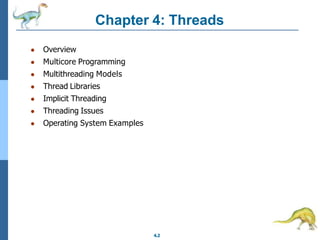Chapter 4 discusses threads as fundamental units of CPU utilization in multithreaded systems, detailing various multithreading models and libraries such as POSIX pthreads, Windows threads, and Java threads. It explores the benefits of multithreading including responsiveness, resource sharing, and economy, while also addressing issues related to concurrent programming and implicit threading methods. Additionally, the chapter compares user and kernel threads, investigates different models, and examines operating system support for threading in platforms like Windows and Linux.





























![OpenMP
● Set of compiler directives and an
API for C, C++, FORTRAN
● Provides support for parallel
programming in shared-memory
environments
● Identifies parallel regions –
blocks of code that can run in
parallel
#pragma omp parallel
Create as many threads as there are
cores
#pragma omp parallel for
for(i=0;i<N;i++) {
c[i] = a[i] + b[i];
}
Run for loop in parallel
4.30](https://image.slidesharecdn.com/ch4-240509094300-09d6fb6e/85/Operating-systems-Introduction-to-Threads-30-320.jpg)















